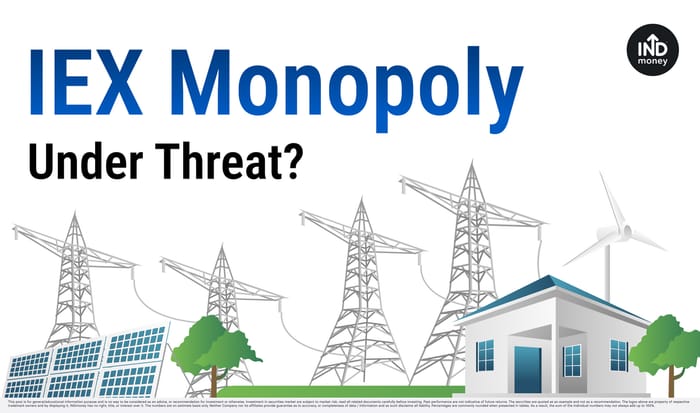
- What Happened?
- Why Did the Market React So Strongly to the News?
- What is Market Coupling that affects the IEX Share?
- What Is the Day-Ahead Market (DAM)?
- What Does This Mean for IEX?
- Why BSE/NSE Aren’t Involved in Electricity Price Discovery
- Final Thoughts
Indian Energy Exchange (IEX) shares crashed more than 25% to trade below ₹140. This sudden fall was triggered by a key regulatory announcement that could impact IEX’s dominant position in India’s power trading market.
Let’s understand what changed, what market coupling means, and how it affects IEX.
What Happened?
The Central Electricity Regulatory Commission (CERC) has approved a phased rollout of market coupling for the Day-Ahead Market (DAM) starting January 2026.
This change will bring a centralized pricing mechanism to India’s power market. Until now, each power exchange set its price based on demand and supply. For example, IEX discover its own price through its system. Going forward, a single price will be used across all exchanges.
Why Did the Market React So Strongly to the News?
IEX has long enjoyed a monopoly in power trading, with a market share of 84.2% as of FY25.This is because of high liquidity and volume on IEX which .led to efficient price discovery. Most of the volumes on IEX, about 90%, come from the Day-Ahead Market (DAM).
With the new framework:
- IEX will lose control over price discovery.
- Smaller exchanges like PXIL and HPX will get access to the same pricing.
- IEX could lose market share, especially if participants shift to platforms that offer lower transaction fees.
- Revenue and margins may come under pressure as pricing advantage fades.
These risks triggered strong selling by investors and concern among brokerages, leading to the sharp fall in the stock price.
What is Market Coupling that affects the IEX Share?
India currently has multiple power exchanges:
- IEX – the dominant player
- PXIL – a smaller exchange
- HPX – a new entrant
Right now, each of these runs separate auctions, which can result in different prices for the same delivery day.
Market coupling will change this by introducing:
- One common clearing price across all exchanges
- A central algorithm, likely managed by the Grid Controller of India, to match bids and allocate trades
- A fair distribution of trades across exchanges based on demand and supply
What Is the Day-Ahead Market (DAM)?
The Day-Ahead Market is a key platform where electricity is bought and sold one day in advance. Here’s how it works:
- Power generators (like NTPC, Tata Power) offer to sell electricity at a set price.
- Power buyers (like state discoms and private distributors) place bids to buy.
- The exchange (such as IEX) matches buyers and sellers through an auction.
- A clearing price is set, and trades are confirmed.
The DAM plays a vital role in ensuring stable power supply and cost efficiency. It is also the largest segment of trade on IEX.
What Does This Mean for IEX?
Possible Benefits:
- The market becomes more transparent and efficient
- Lower risk of price manipulation
Key Risks for IEX:
- Loss of pricing power
- Potential decline in volumes if users migrate to other exchanges
- Pressure on revenue and margins
These risks directly affect IEX’s core business, which explains the sharp market reaction.
Why BSE/NSE Aren’t Involved in Electricity Price Discovery
Even though BSE and NSE are large exchanges:
- They don’t operate under the Central Electricity Regulatory Commission (CERC).\
- They don’t have licenses to run electricity markets.
- Electricity trading involves physical delivery, transmission capacity, and real-time grid coordination, none of which stock exchanges handle.
Final Thoughts
While market coupling aims to improve transparency and fairness in electricity trading, it also reshapes the competitive landscape. For a company like IEX, which has built its business on scale and price leadership, the new rules could mean lower growth visibility and increased competition.
As the implementation draws closer, investors will closely watch how IEX adapts and whether it can retain volumes in a more level playing field.
Disclaimer
Investments in the securities market are subject to market risks, read all the related documents carefully before investing. The securities are quoted as an example and not as a recommendation.This is nowhere to be considered as an advice, recommendation or solicitation of offer to buy or sell or subscribe for securities. INDStocks SIP / Mini Save is a SIP feature that enables Customer(s) to save a fixed amount on a daily basis to invest in Indian Stock. INDstocks Private Limited (formerly known as INDmoney Private Limited) 616, Level 6, Suncity Success Tower, Sector 65, Gurugram, 122005, SEBI Stock Broking Registration No: INZ000305337, Trading and Clearing Member of NSE (90267, M70042) and BSE, BSE StarMF (6779), SEBI Depository Participant Reg. No. IN-DP-690-2022, Depository Participant ID: CDSL 12095500, Research Analyst Registration No. INH000018948 BSE RA Enlistment No. 6428. Refer https://indstocks.com/pricing?type=indian-stocks; https://www.indstocks.com/page/indian-stocks-sip-terms-and-condition for further details.